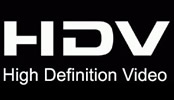
HDV had its time and place. For documentary work, there’s really no media that gives you the sense of security like tape. You walk off set with real, touchable pieces of plastic knowing that your footage exists in a physical piece of plastic. Solid state cameras remove that reassurance and you instead marvel that your days, weeks, or months of shooting only exist on a hard drive…which could fail or be formatted at a moment’s notice.
However HDV has it’s well-documented flaws. The camera heads have to constantly be cleaned, tape cameras have a (relatively) large number of moving parts which means more potential problems (had tape transport jams twice on a shoot once), and HDV itself was… well, 4:2:0 DV bitrate in HD. Ouch. Still, videographers everywhere made good use of HDV. I remember reading that Planet Earth was utilizing HDV… if it’s good enough for those guys, what do I know??! (granted they were using it for slow moving shots)
I digress. The one piece of the HDV workflow that always bugged me was “capturing”. Several years ago, I worked as a technical assistant at a web/video company. Part of my job was to log and transfer countless hours of DV/HDV tape into the computer. I have no problem with log and transfer. Editors should know their footage well. What bugged me was the play>pause>reverse a few seconds>play>pause>reverse a few frames>play>capture sequence. Once footage was loaded into an NLE, in and out points were easy and instant… but setting 20 in/out points on tape in capture seemed to turn a 60 minute tape into a 90 minute capture. Though I was paid hourly for the work, I often thought to myself… “there has to be a better way”.
Funny enough, when starting my business, I started with an HDV camera. Recently, it came time for an upgrade (aside from the DSLR revolution). Weighing my options carefully, I choose the Sony EX1R as my solid state camera system, which uses the XDCAM codec.
From a workflow perspective the XDCAM codec is great for several reasons:
1) It’s a mere 35mbps in camera, with the option to record 10 bit to an external recording, allowing fairly long recording times on manageable media (16, 32 GB cards) as well as higher end codecs for professional applications.
2) The XDCAM codec is supported by Avid, Adobe, and FCP so it fits into many different types of workflows and can go from Mac to PC easily.
3) The cards are hot swappable in camera so you can constantly dump and shoot.
4) Timelapse work is a breeze with the single-frame interval recording feature
5) Pro audio in, no need to sync second system audio
6) Each time you start/stop recording, a new file is created. A new system of log and transfer.
I’ll often pair the EX1 with a Canon 5D/7D, maintaining the tapeless workflow (though the DSLRs do add complication in post).
My goal with the new tapeless workflow is to keep it simple with as little obstruction as possible.
Record -> Transfer -> Log -> Edit -> Export
Thoughts?

Comments
It’s a tool, and like any tool it’s only as good as the person wielding it. That being said, congrats on moving into a better workflow. Occasionally I deal with HDV on shoots, so I know the trials it can bring. An EX1 is a good choice!